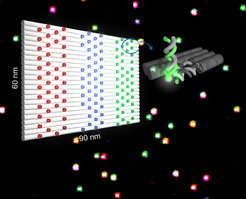Multicoloured microcosm: 124 colours thanks to RGB technology

Red, green and blue: normally, no more than three different colours can be detected simultaneously in fluorescence microscopy. Thanks to recent RGB nanotechnology, similar to that used in computer monitors, it is now possible to generate 124 virtual colours under the microscope. The three primary colours are arranged in various mixing ratios on a special DNA lattice. This creates individual colour pixels under the microscope. The new method was developed by scientists at the Max Planck Institute of Biochemistry, Ludwig Maximilian University of Munich, Germany, and the Wyss Institute for Biologically Inspired Engineering at Harvard University in the US. The team’s work was published in the journal Science Advances
Biomedical research has made tremendous strides in recent decades. Using the latest microscopes, scientists are analyzing the function and interactions of molecules in cells with ever greater detail. Now, researchers are looking for methods to image multiple molecules simultaneously.
RGB nanotechnology
A team of scientists from Germany and the US headed by Ralf Jungmann and Peng Yin has now developed substances known as metafluorophors. “The technology can be compared to that of an RGB monitor,” explains Jungmann, Leader of the Molecular Imaging and Bionanotechnology Research Group. To display a wide range of colours on a screen, each colour is mixed from the three primary colours: red, green and blue. “We’ve transferred this approach to the nanometre scale. Instead of a single fluorescence dye molecule, multiple fluorescent molecules are applied to a carrier material, which serves as a kind of experimental board. Depending on the proportion of the three primary colours, they appear in different colours under the microscope, comparable to nanometre-scale colour pixels on a computer screen.“
